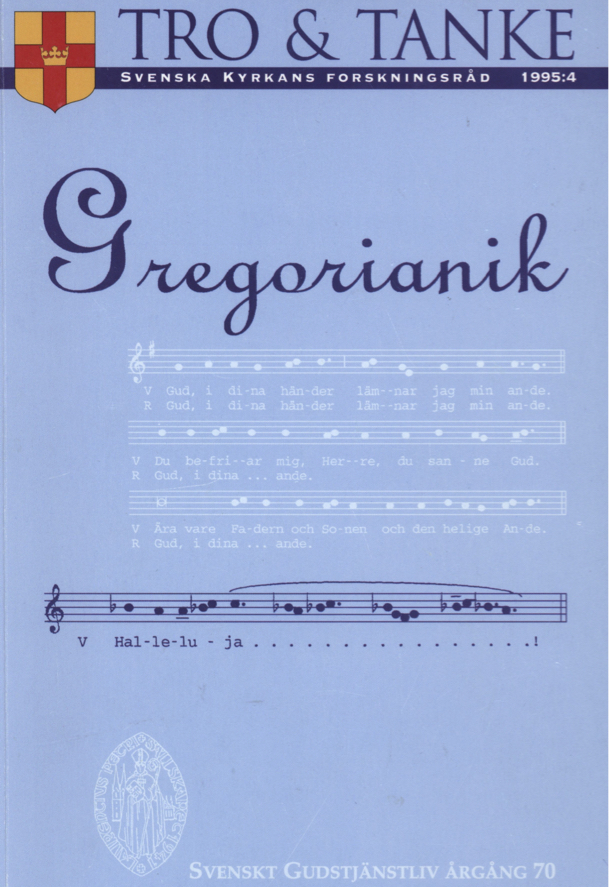Gregorianiken i mässan
Abstract
The aim of the article is, firstly, to make an inventory of the supply of Gregorian songs in the Church of Sweden service according to the Service Book-Music, and also to study some adaptations to Swedish of Latin melodies mostly taken from the Graduale Romanum.
The latest results of Medieval research on Gregorian performing practice gives cause to the scrutinizing, in the light of these new observations, of what is written in the Service Book instructions on the performance of Gregorian Music.
The Service Book contains many new liturgical songs, but is nevertheless characterized by great traditionalism with several elements of old music. Today, a wider scope in Mass music is being wished for. Mass music, which is composed, e.g., in the tradition of Swedish folk music, is wanted.
Finally, the article asks questions of what possibilities Gregorian music would have in the above-mentioned wider, popular context. Does it have qualities that other kinds of church music do not have?
An inventory of the Gregorian repertoire of the Mass shows that there is Gregorian music for all parts in the ordinary of the Mass, except the Credo. The same goes for the following parts of the proper: introit, Psalms to be used, e.g., between the Old Testament reading and the epistle (and as alternative introit), sequences to be used as hymns, intercessions/ litanies, and prefaces. In total, the Service Book contains somewhat more than 120 liturgical songs. More than 70 are of Gregorian origin. The introit part has the most Gregorian songs - 51 - while the ordinary has 17 Gregorian alternatives.
In todays liturgical reality, the Gregorian alternatives are very often being used in the ordinary of the Mass, but the new ones are probably as frequent, at least in the Kyrie and Gloria Parts. The greatest Gregorian repertoire - the introit - is in very little use, as long as one nowadays wishes to activate the congregation here. Therefore, our church musicians prefer psalms with refrains sung by the congregation to Gregorian introits, which are primarily intended for the choir.
Adapting Latin melodies to the Swedish ordinary is difficult, as it is a question of texts officially approved, which cannot be changed. The differences are big between the Swedish and the Latin texts, concerning the quantity and the stress of individual words. The Swedish Kyrie is the easiest to adapt. I exemplify an adaptation of some Mass texts. Examples 4 and 5 are my own suggestions for an adaptation of two Kyrie melodies; examples 11 and 12 present my own attempts at adapting two introits from the Graduale Romanum.
Recent research - so-called semiology - has made the Service Book directions for musical performance age quickly. The interpretation has been too optimistic concerning the signs from the neume manuscripts which have been put above all into the introit. Actually, one does not really know anything for sure of the way Gregorian music was originally sung. If there is a wish for rules for the execution, the most appropriate rules would be the Solemnes ones of 1983 (printed in Liber Hymnarius).
We should continue using Gregorian music at Mass, and the repertoire should be enlarged by Latin Gregorianism. The Kyrie and the Agnus Dei could be sung in the original by the choir and - later on, why not also - by the congregation. Also the introit should be sung by the choir in Latin as meditative songs after readings and during Communion.
Gregorian music is part of Swedish music tradition since the Middle Ages and a priceless heritage. It has great aesthetic qualities and its character is ecumenical. It is genuine Church music which has been associated with Church prayer for thousands of years.
Downloads
Publicerad
Nummer
Sektion
Licens
© författarna, Laurentius Petri Sällskapet för svenskt gudstjänstliv samt Artos & Norma bokförlag. Det är tillåtet att kopiera och använda material ur Svenskt Gudstjänstliv för forskningsändamål om källan anges. För övriga ändamål kontakta respektive artikelförfattare samt förlaget. Särskilda restriktioner kan gälla för bildmaterial.


